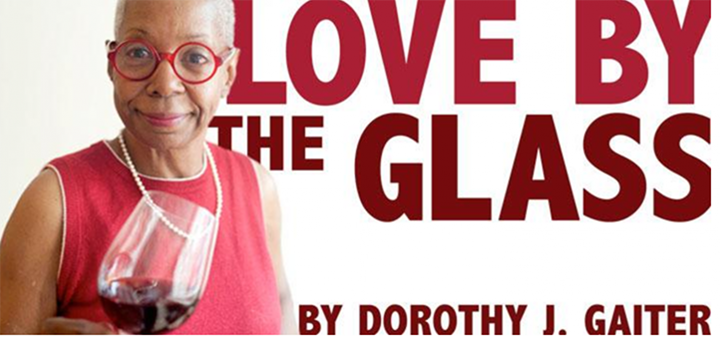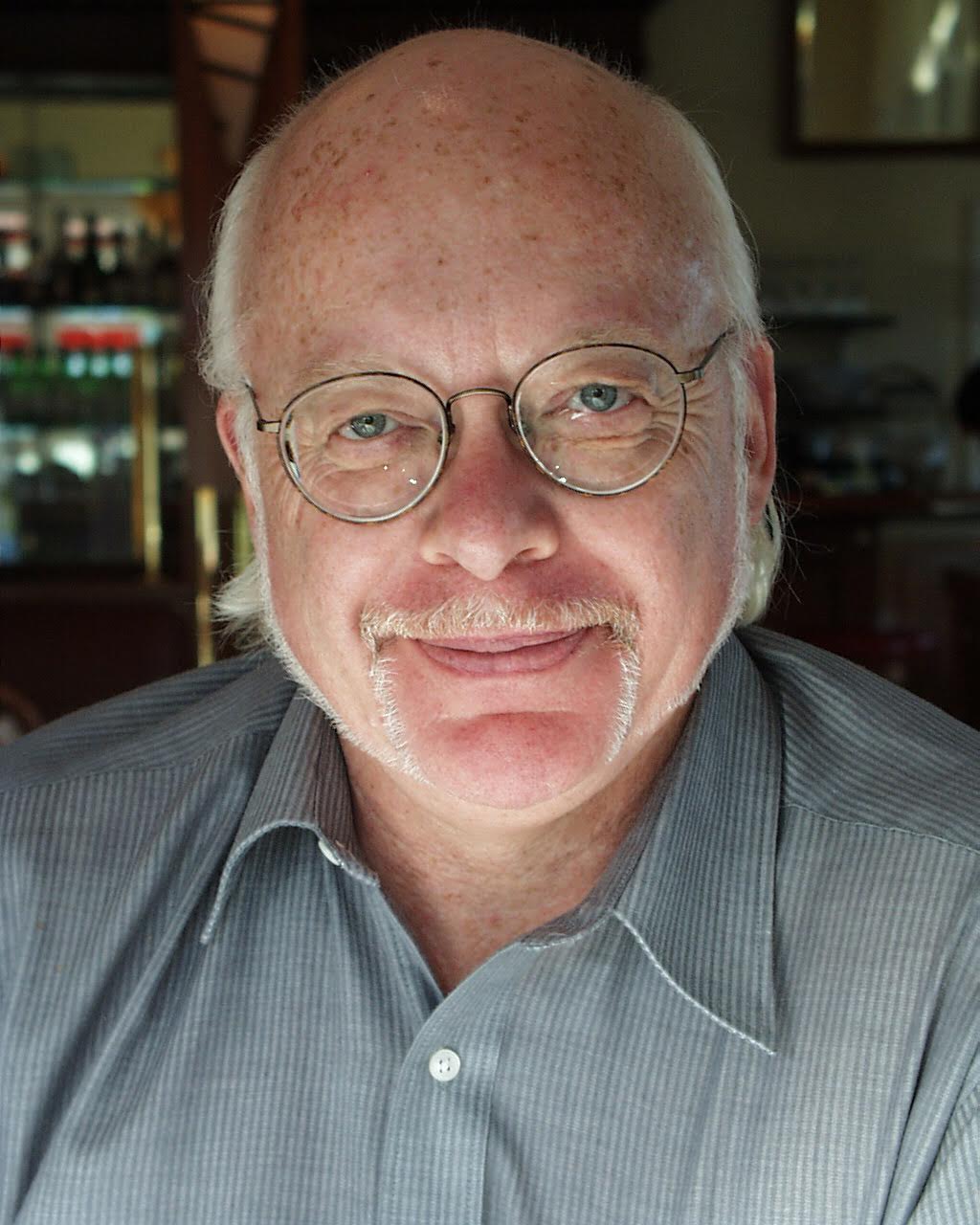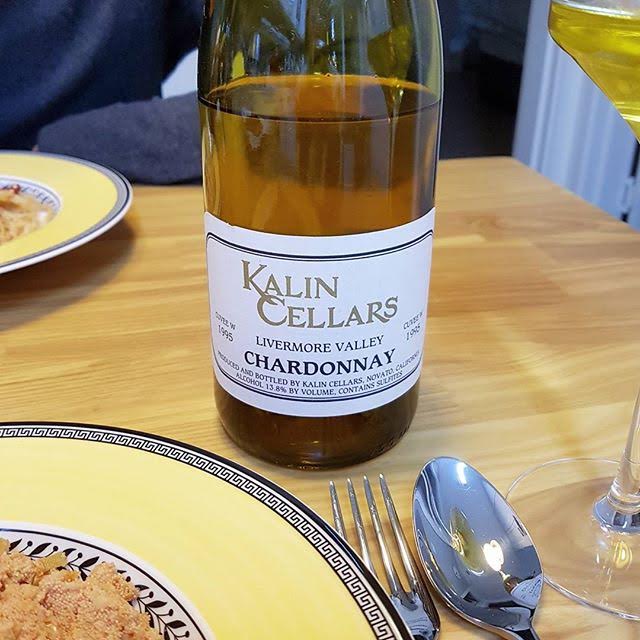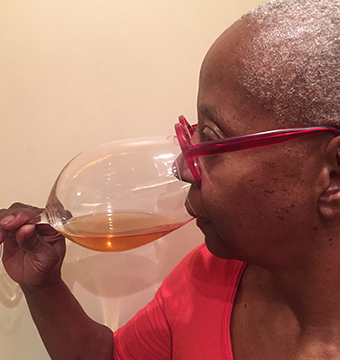
It is our routine, when going on cruises, to take grower Champagne and older wines from our cellar. Rarely do we even look at anything that’s young. With wines that are dear to us, and with the ship’s chefs' dishes, we look forward to hours of solitude talking and gazing at each other as the wines change. John tries to plot dinner times and locations so that we’re often sitting on the correct side of the ship to watch the sun sink into the ocean. Yes, it is possible to feel completely alone on a ship with thousands of people. Our wines help usher us into that perfect place.
So I was surprised last November when John handed me a wine to pack for the trip that he said had been released only two years ago. It was a 1995 Kalin Cellars Cuvée W Livermore Valley Chardonnay--released when it was 20 years old! He had bought me four bottles of it, a present. (Crush Wine & Spirits in Manhattan was selling a four-pack, he later told me, for $35.95 a bottle, a criminally low price. Wine-searcher says its average price is $44.) The winery was not entirely new to us. We had Kalin’s 1988 luscious Cuvée DD Chardonnay Alexander Valley in 1990, a seriously quick turnaround for this winery, it turns out.
 Microbiologists Terrance Leighton (photo right), 71, and his wife, Frances, founded Kalin Cellars in Marin County, California, in 1977, intent on making classic, European-style wines using traditional, minimalist methods. The 7,000-case winery in Novato, north of San Francisco, has such a cult following among lovers of well-aged wines that hard-core fans—customers, restaurants and retailers--are called Kalinites. One Kalinite, Robert Parker, described them as “the wines of a genius.” The vintage, 1995, was a great one, he added.
Microbiologists Terrance Leighton (photo right), 71, and his wife, Frances, founded Kalin Cellars in Marin County, California, in 1977, intent on making classic, European-style wines using traditional, minimalist methods. The 7,000-case winery in Novato, north of San Francisco, has such a cult following among lovers of well-aged wines that hard-core fans—customers, restaurants and retailers--are called Kalinites. One Kalinite, Robert Parker, described them as “the wines of a genius.” The vintage, 1995, was a great one, he added.
“Genius” is spot-on here. The wine on the ship, unfiltered and aged sur lies, had been so incredible that we had another bottle last week for my birthday. Blown away again by this complex and soul-satisfying wine, I called Terrance, the “eccentric genius” who made them, a couple days later. Friends call him Terry. A Hungarian princess, who was Frances’ best friend, introduced them when they were all studying microbiology at the University of British Columbia, Terry told me. Both Leightons hold doctorates in microbiology, ideal for making the type of wine they make.
When we spoke, he and Frances were still waiting for the right time to release their 1989 Blanc de Blanc. “Those are barely ready to taste. The Blanc de Blanc has been disgorged but it’s still sort of making its way, as Salon does in some vintages,” he told me.
The Leightons believe wines can achieve that fifth taste, umami, a sort of savory nirvana for the palate, if they are meticulously made and given time to reach near peak perfection. This means holding on to wines for years while they age -- he prefers the word “mature” and sometimes releasing them out of sequence. At Kalin, white wines are generally released five to 10 years after the vintage, he said, and red wines six to 10 years. In a great vintage, and he and many others agree that 1995 was a stellar year in California, the wines can go a lot longer.
“We release them when they taste good,” Frances has been quoted as saying. Richard Nalley quotes her in his fine 1998 piece in Departures magazine as saying of the sediment that’s sometimes in their wines, “If it doesn’t have crud in the bottle, it isn’t Kalin.” Kalin, by the way, is a Native American word for “ocean,” chosen, they have said, because it’s the only Native American word they could pronounce.
 Kalin’s motto is “Produce No Wine With Less Character Than Yourself” and the two 1995 Cuvée Ws vibrated with character.
Kalin’s motto is “Produce No Wine With Less Character Than Yourself” and the two 1995 Cuvée Ws vibrated with character.
“Looks like tea, a deep gold with light shot through it. Surprising color. Rich, luscious. Great acidity, amazing acidity. An early cider-like whiff blows off. Mango, orange rind, green olives, papaya, stones, minerals, like boiled-down stewed peaches,” we wrote in our notes on the first Cuvée W on the ship. “Everything about it seemed funny, the way it looked and smelled. But the taste, the taste was fantastic.”
“Looks thick but it actually isn’t. Great acidity. A touch cider-like whiff again but that lifts as flavors and the bouquet emerge and merge. Poached pears, orange blossoms, luscious like a Sauternes, but ephemeral in its way. Magisterial. Nutmeg. John says if we’d paid $500 for a Montrachet, we couldn’t be happier. So intense, so sublime. Majestic. Such presence. Absolutely spectacular wine,” we wrote of the second one, last week.
One well-regarded reviewer called the color “suspicious,” but described the wine as tasting fresh. That’s a fair description of the wonderfully startling experience of these wines. Another noted that people unaccustomed to drinking older wines could find these unpleasant. When I asked Leighton about these descriptions and cautions that these are wines that perhaps only those who like well-aged wines would appreciate, he said, “I think that’s a good pre-condition, to make people aware.”
In addition to the 1995 Kalin Cellars Cuvée W Livermore Valley Chardonnay, these are Kalin’s current releases, with prices from Wine-searcher: 1995 Cuvée CH Sonoma Coast Chardonnay, $49; 2001 Livermore Valley Sauvignon Blanc Reserve, the Kalin website states, contains Sémillon “from Wente Vineyards vines planted in the 1880s from Chateau d’Yquem,” $41; and the 1999 Cuvée DD Sonoma Pinot Noir, $48. The 1995 Cuvée L Sonoma Chardonnay is available at here, below, for $49.99. Some of these are also available at the winery. Leighton also makes Sémillon, Cabernet Sauvignon and sparkling wines. Some wines, like the 2001 Livermore Sauvignon Blanc Reserve and the 1995 Cuvée L Chardonnay, are what he and Frances call “Stealth Releases” and have a picture of a Stealth aircraft next to them on the website.
What’s with the name Stealth? I asked.
“That is purposeful,” Leighton responded, laughing. “Because it’s like the aircraft. If you’re not in the right place at the right time, you’ll never see it.” Not much is made of these, “minuscule” amounts, he said, but they also are distinguished from other Kalin wines by getting more sur lies aging and time in the bottle.
The W on the 1995 label signifies that the grapes were from the old Wente clone from the Wente Estate Vineyard in the Livermore Valley. The 1988 Cuvée DD Chardonnay that we had in 1990 had come from David Demostene’s vineyard in the Alexander Valley. The Cuvée L refers to the Long Family, and that 1995 Chardonnay is dedicated to long-time vineyard owner “Jack Long and his wife Melba, Susan his daughter, Rick his son and Rick’s wife Jackie,” according to Leighton. To see “The Kalin Alphabet,” go to kalincellars.com and click on Table of Contents and then scroll down to The Kalin Short Story.
“There are two different types of channels in the wine trade,” Leighton told me, explaining his view of the artisanal winemaking he does and industrial winemaking. “Wines that are essentially fast wines for pleasing the banks, pleasing the investors, pleasing a lot of people who like the popular taste profile or whatever. There’s nothing wrong with that,” he said. “Our view was that we really wanted to make an investment-grade product, something you can buy that will increase in value over time.

(Note deep gold of Gaiter’s 1995 Cuvée W.)
“We knew, more or less, what the methodology was to do that. Quite a lot of people know how to do that, but the banks don’t like it. A lot of people want to be out with the flashy new vintage when everyone else is so they don’t get left in the dust. It’s a kind of economic dilemma. We just thought that we’d do something different.”
And different it is, in the way they make it, and the way it looks and tastes. He and Frances have never had any investors. It’s always been just them and their Francophile tastes. “Don’t quit your day job,” he said with a chuckle. His day job, for decades, was professor of microbiology at UC-Berkeley. He retired as emeritus professor in 2002 and continued to do research at Children’s Hospital Oakland Research Institute. He still does basic and applied research in microbiology and consulting work.
When I asked how they made the successful transition from microbiology to winemaking, Leighton told me, “As Louis Pasteur said, ‘Chance favors the prepared mind,”’ quoting the French biologist, chemist and microbiologist renown for ground-breaking discoveries concerning vaccination, pasteurization, and, most important here, microbial fermentation.
“We knew we could do things that weren’t really being done back then: barrel-fermenting Chardonnay, bottling red wines without fining or filtering, using a minimalist approach, and selecting exactly the right strains of yeast to bring out the specific character of any given vineyard,” he said. “That’s the thing about being microbiologists: We were just never terrified about trying these things because we understand the scientific basis that makes them work.”
When they started, he said, “No one understood malolactic fermentation at all and how to control it. No one understood that selected yeasts might be better than whatever homeless strain of yeasts you might find” in a vineyard, he told me. Ever the careful scientist, he acknowledged that many winemakers value native, wild yeasts and if it works for them, he said, great.
“We wanted a strain of yeast that wouldn’t make any off-characters and that sort of thing, but would be basically an amplifier for terroir so that it would bring out the innate characteristics of the climat [the specific, unique location] and not add much of the tutti frutti stuff or other types of exotic, non-wine things,” he said.
Through experimentation, they were able to match yeast strains to grapes and vineyard sites to produce the wines they long envisioned. Louis Pasteur, again, helped. I know he died in 1895. I’m really talking about the not-for-profit Institut Pasteur in Paris, whose mission, according to its website, is to “to help prevent and treat diseases, mainly those of infectious origin, through research, teaching, and public health initiatives.”
Pasteur, you’ll recall, was “the first to demonstrate experimentally that fermented beverages result from the action of living yeast transforming glucose into ethanol [that’s drinking alcohol, to you]. Moreover, Pasteur demonstrated that only microorganisms are capable of converting sugars into alcohol from grape juice, and that the process occurs in the absence of oxygen.” OK, that’s the succinct description from Scitable, a social network for science research and education from the Nature Publishing Group.
While searching for the right strains of yeast to use, Leighton told me he called the Institut, where someone there told him that they were so happy to hear from him. Because no one had shown interest in it, they were planning the following year to dispose of the yeast collection that Pasteur had selected. Can you imagine? “So I said, let me give you the address of their new home,” Leighton recalled that he had said.
Before we talked, I had emailed him a few questions. The first was: What career plan had you had when you decided to make wine? He had responded, “Frances and I are microbiologists. If microbiologists don’t have something to contribute to wine science...in the service of art...Louis Pasteur is rolling in his grave!”
That only grazed the question, so when we spoke, I asked again. But let’s back up and start with the Hungarian Princess. She had “escaped during the Hungarian Revolution [1956] under very difficult circumstances and ended up immigrating with her family to Canada, where she was a microbiology student,” Leighton said. He was getting his doctorate in microbiology and working as a teaching assistant in the laboratories there and Frances, also a microbiology student, was the princess’s best friend. The princess, he said, “decided that Frances and I should meet each other.” The princess went on to work at Harvard Medical School and married a Harvard physician and Terry, who’s originally from Idaho, and Frances got married in 1968.
The couple liked wine and while in Vancouver took a “dead serious class” that taught them a lot about “significant classified growth châteaux” including their “grapes, the styles, the history, the techniques, etc. etc. We found that pretty interesting,” Leighton added.
After they’d moved to California, they met local winemakers. Hanging out at tastings in San Francisco, they met other folks who, when they learned he taught microbiology at Berkeley, approached them with a proposition. These people were establishing a winery to make “Port,” and offered them a lifetime supply if they would help them avoid microbiological disasters. So he and Frances accepted and worked out of an old bakery in Emeryville, which at the time was “not too safe,” an area, he said. But there were perks. Another occupant made “drinkable bulk wine,” he said, and Diamond Wine Merchants, an importer of “great Burgundy wines” was a neighbor. “We got corrupted early,” drinking fabulous Burgundies, he added.
“Eventually we figured out there were a lot of things at that point we could do as microbiologist that people weren’t doing. There was plenty of space there so we bought grapes and barrels and started making stuff,” Leighton told me. “At one point, we had the audacity to charge $6 a bottle for Zinfandel and Pinot Noir. In that era, that was considered crazy. Really high. It all sold in three months!”
The first vintage was 1975. One weekend day while working in their space, they heard loud banging on the door. “Frances said, ‘Hmmm, you’d better answer that.’ So I opened this big heavy door and there were two guys out there in suits and one of them says, ‘We’re from Park-Benziger in New York and we want to distribute your wines throughout the United States.’ So I said, Oh, OK, why don’t you come in?”
It was the beginning of a profitable relationship for everyone. Eventually, Leighton said, he and Frances helped the Benzigers’ children establish Benziger Family Winery in Sonoma and other ventures. In his early days, he also made sparkling wine for Domaine Laurier, and wines for a country club in Hillsborough, California. Kalin is currently represented by Polaner Selections. Doug Polaner emailed me that these New York City retailers have bought Kalin wines recently: Astor, Chambers Street, Flatiron, Crush, Morrell, Vintry, Some Good Wine, Vinyl Wine and Morton Williams Wine & Spirits.
The Leightons also make and sell wine from two small Pinot Noir vineyards they bought in Burgundy years ago. The Kalin Bourgogne “Les Chouacheux” and Kalin Bourgogne “Les Pierres Blanches,” both 2001, are the current releases. Frances oversees the vineyards in France and deals with French bureaucracy, Terrance said, and he goes over several times a year to guide the Burgundies. Their California fruit is sourced from painstakingly selected vineyards and from farmers who over decades have become friends, like Jack Long’s family, whose vineyard is in Dry Creek.
 Their concept, according to their website, is basically to make wines “in the Grand European tradition for American budgets.” And their goal? “We are trying to put the same level of quality and personal attention into our wines as Domaine de la Romanée-Conti,” he said. They are Kalin’s only fulltime employees and get by with help from friends and others. All grapes are hand-picked and all wines from single vineyards.
Their concept, according to their website, is basically to make wines “in the Grand European tradition for American budgets.” And their goal? “We are trying to put the same level of quality and personal attention into our wines as Domaine de la Romanée-Conti,” he said. They are Kalin’s only fulltime employees and get by with help from friends and others. All grapes are hand-picked and all wines from single vineyards.
Leighton adheres to this advice from Dick Graff, a pioneer of modern winemaking in California, at Chalone Vineyard, who was killed in a plane crash in 1998. Foley Family Wines now owns Chalone. “Add nothing, and take nothing away,” Graff had said.
Since 1981, all Kalin whites have been bottled without filtration, and reds also are bottled without filtration and without fining, or the addition of juice other than first-pressed juice. Leighton believes that not filtering the wines gives the wine drinker a more authentic experience of the vineyard and the vintage. For white wines, grape juice goes into small oak barrels, sometimes 50% new French oak, where it will ferment and undergo a second fermentation, malolactic, and age sur lies. The extended barrel and sur lies aging give the wine more complexity. Before it goes into the bottle, the white wine is fined. At first the whites “look like Perrier,” they’re colorless, so the Leightons watch for them to begin to show color as they age and change on their way to the rich, deep gold we experienced.
“Another axiom of winemaking, is ‘To make really good wine you have to throw wine away,’” Leighton told me. Winemakers should get rid of stuff that others would send through filters so that they could get more juice. And they shouldn’t press and press and press red grapes to wring out every bit of juice because that contributes substances that taste bitter. “Graff was a very smart guy. What he said is worth repeating and popularizing, especially in these days with vast amounts of joojoo that we can add to wine,” Leighton told me.
A handful of journalists have quoted Robert Parker describing Kalin as “the wines of a genius,” while others have attributed the “eccentric genius’’ description to Antonio Galloni, a former Parker taster and founder of the website Vinous.
Golly Gee. What’s it like to have people use words like that to describe you? I asked Leighton toward the end of our conversation.
“I don’t know,” Leighton replied, laughing. “It’s kind of nice to have people say stuff like that, but don’t believe your own P.R., OK?”
I think it’s probably safe for him to believe it.
Dorothy J. Gaiter conceived and wrote The Wall Street Journal's wine column, "Tastings," from 1998 to 2010 with her husband, John Brecher. She has been tasting and studying wine since 1973. She has had a distinguished career in journalism as a reporter, editor, columnist and editorial writer at The Miami Herald and The New York Times as well as at The Journal. Dottie and John are well-known from their many television appearances, especially on Martha Stewart's show, and as the creators of the annual "Open That Bottle Night" celebration of wine and friendship. The first bottle they shared was André Cold Duck.
Read more of Dorothy J. Gaiter on Grape Collective.
Find Kalin Cellars on Winesearcher or at Grape Collective.










